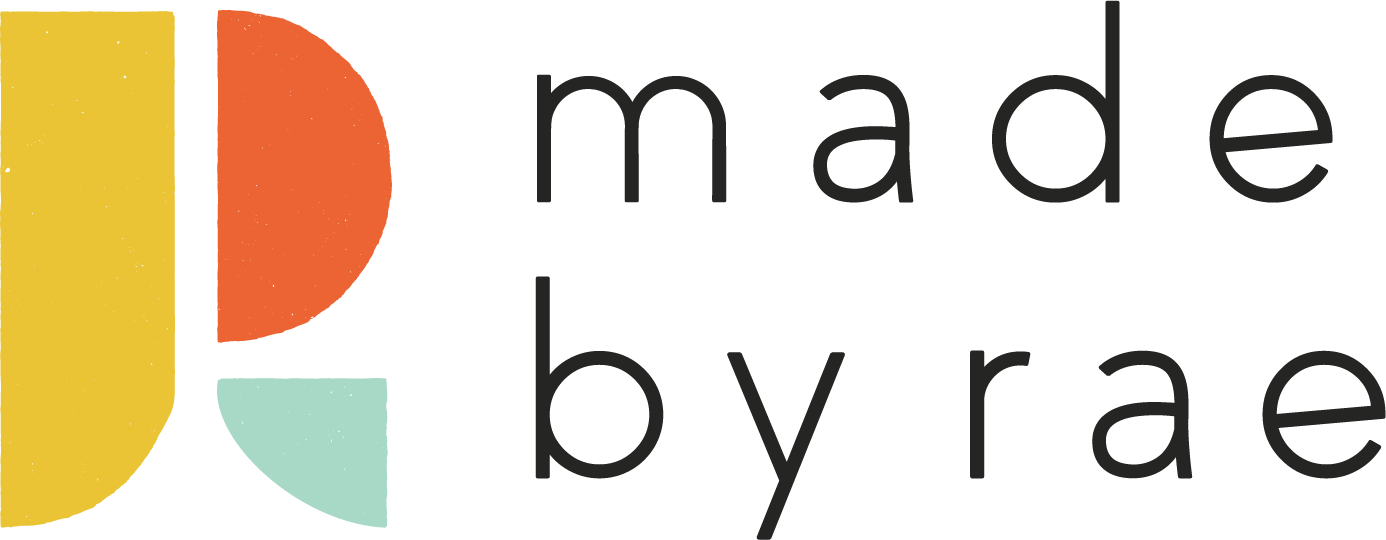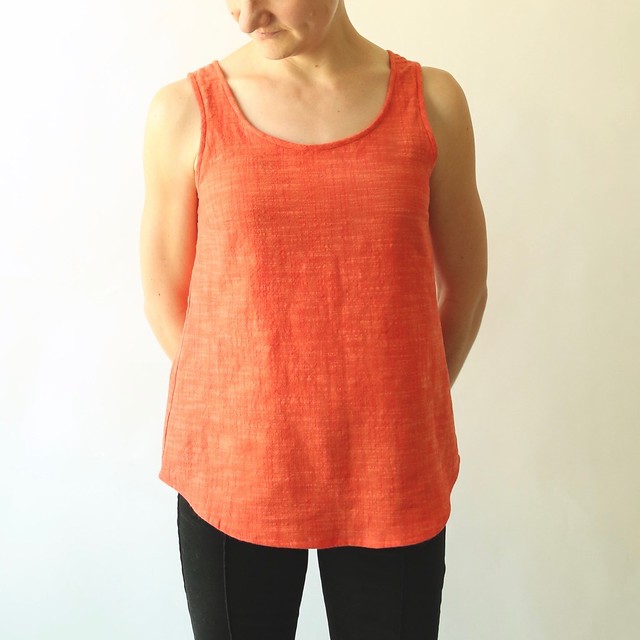Selecting fabrics for Gemma
Gemma tanks are a great summer staple, and we at MBR have been been putting ours into heavy rotation now that the weather’s warming up. Jess has easily made more Gemmas than I have, and I dare say has become a bit of an expert at selecting good fabrics for this pattern, to the point that I might even be a wee bit envious of hers (all I’m saying is she’s lucky she’s a size smaller than me otherwise they might start to disappear).
Jess is general manager here at Made By Rae (she is in charge of wholesale, coordinates pattern testing, serves as project manager, and answers a ton of email), and she does a lot of sewing both for work and for fun. Jess made this particular Gemma tank with Robert Kaufman Manchester cotton in Poppy, a looser weave medium-weight cotton that has turned out to be a really comfortable Gemma.
The other day we were discussing this tank, and that led to a discussion about our favorite fabrics for Gemma, because ultimately the ones made with fabrics that are more comfortable will get worn, and the ones that aren’t, won’t. That seemed like a great topic to share on the blog, as I know many of you are also sewing Gemma tanks of your own (check out #gemmatank for some great examples).
Fabric choice is one of the most important factors if you want to end up with a comfortable garment, especially when you are working with woven fabrics (knits are, by their nature, usually more comfortable to wear, but Gemma is designed for wovens). Here are a few things to consider when selecting fabric for Gemma:
a fabric with a looser weave tends to be more comfortable than tighter weave.
a fabric with a lighter weight tends to be more comfortable than heavier weight
a fabric with more drape tends to be more comfortable than fabric with less.
Every fabric has some degree of each of these characteristics (weave, weight, drape), as well as other characteristics that have less impact on comfort, but in general, I find these useful when choosing fabrics for Gemma.
Here are some more fabrics to consider making your next Gemma out of:
double gauze – while it’s not super drapey, it’s fairly lightweight and has a very loose weave, to the point that you might even need to go down a size. Double gauze frays quite easily (so seam finishing is a must!), but the darts are easy to get to lay smoothly and it’s actually quite manageable to sew with, due to the stabilizing effect of the two layers. Manufacturers include Kokka, Andover, Monaluna, Cloud9, and Cotton and Steel.
shot cotton – also lightweight and with a looser weave but very little drape, this is a nice option if you can find it (as far as I know, Kaffe Fassett is the only one who designs shot cottons). I love the depth of solids due to the different colors in the warp and weft threads. Manufactured by Free Spirit.
cotton lawn / voile – lawn has the advantage of being widely available in many different prints due to an increased number of manufacturers producing it in recent years, and it is light weight. Be careful when using lawn for Gemma, however, as some of the lawns (looking at you, Cotton and Steel) are very tightly woven and less lightweight than others, and even have a bit of a silky sheen to them, making it less comfortable to wear and a more difficult to sew the dart smoothly without a noticeable pucker at the end. Manufacturers include Windham, Andover, Robert Kaufman, Liberty of London, Free Spirit (under “voile”), Cloud9, Monaluna, and Cotton and Steel.
chambray – most chambray is medium-weight, fairly tightly woven, and has very little drape, so in general I would avoid it for Gemma. However, the fabrics under the category “union chambray” produced by Robert Kaufman have become popular in recent years because they are lighter, drapier, and even have a bit of stretch to them. Manufactured by Robert Kaufman
rayon / rayon challis – a synthetic fiber that drapes beautifully, the quality will determine how easy it is to sew with, but one thing to consider (and one that I need to do more research on, frankly) is that rayon production can be pretty horrid for the environment; rayon tencel is the most eco-friendly rayon. Manufacturers include Free Spirit and Cotton and Steel.
batiste – in the past year Cloud9 (the organic fabric company that produces my fabric designs), has begun producing a fabric on a new “batiste” substrate for them; it’s loose-weave and light, so it’s almost a single gauze, but it’s less sheer than gauze. The prints they’ve released so far on batiste are quite lovely; however, it’s best to choose prints with darker backgrounds if you use this fabric for Gemma as they are still pretty sheer. Manufactured by Cloud9.
And now, a note about quilting cotton (dum dum DUMMMMMM): It’s not a great fabric for Gemma (or garments in general, really). I know…there are so many awesome prints, but it’s not going to be as comfortable to wear as the fabrics listed above. Even the quilting cottons that are lighter weight (like the one I made with Alison Glass’ Handcrafted fabric) end up looking great on the hanger but not so great to wear. I’d recommend QC for making a wearable muslin, but that’s pretty much it. Sorry.
Do you have a favorite fabric for Gemma? Let us know in comments! You might also want to check out this post: My top five fabrics for clothing.
The Gemma Sewing Pattern is available as a PDF in my shop.






